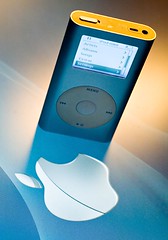
Last week on the way back from San Francisco I read an interesting article in USA Today called “Religious Teaching Straight to Your iPod” that began as follows:
The Rev. Bruce Walker preaches to a congregation of fewer than 100 people in Greenville, S.C., but people all over the world listen to his sermons via podcast.
Evangelists have long used the airwaves to get their messages out to a mass audience. But now, podcast technology is opening the doors to a wider variety of religious teaching than ever before, available on demand and delivered automatically to the computers of a growing number of Americans hungry for spirituality.
A survey last year by the Pew Internet & American Life Project found that more people used the Internet to look for religious and spiritual information than to download music, participate in online auctions or visit adult websites.
While I’m skeptical of the relative “markets” for spirituality vs. smut, I’ve written before about the strong potential for churches to use podcasting as an alternative to broadcasting over the airwaves. And because music typically has copyright restrictions designed to protect profits, and because few pornographers are altruistically motivated to give their content away, these two sectors are probably less-suited for podcasting. Churches, by contrast, generally want as many people to hear their messages as possible, so religious content is ideally suited for this environment that encourages linking and sharing.
One of the main drawbacks of broadcasting is that sermons rarely follow the exact half-hour or one-hour format required for terrestrial or satellite radio. As a result they are either trimmed to fit, or may be stretched over two days, with considerable overlap. Neither of these solutions is ideal.
With a podcast, you don’t need to choose between redundancy or loss of meaningful portions of the message. If the sermon is 33:28, that’s fine, and so is 42:53. In fact, there’s no length that doesn’t work. A podcast is like TiVo for audio. Your listeners can partake whenever it fits their schedule, and you don’t need to meet a mass media-induced time limit. And pastors are already delivering the sermons; it’s just a matter of recording an existing activity, so there’s also no need to produce filler material to pad a broadcast slot.
Technology can’t replace genuine in-person fellowship, but it can enable more effective distribution of content at a lower cost, and far beyond the radius of a local radio tower.
The USA Today article mentions SermonAudio.com as a hub for Christian content, with a reasonable cost of $29.99 a month for churches to upload and distribute their messages. While that’s certainly not an extravagant cost, considering that $360 a year is far less than what you might spend for a single 60-second spot on a major commercial station in many local markets, churches do have cheaper alternatives, as SMUG podcasting curriculum students will discover. You can publish a podcast for $20 a year through the method I will be demonstrating, and to learn how to do it I have an offer for SMUG students to produce and distribute their own podcasts at absolutely no cost.
Meanwhile, if you’d like to check out some religious podcasts, here are the ones I recommend:
- Desiring God Sermon Audio, featuring Dr. John Piper. This is perfect for the podcast medium because the messages are highly variable in length. In fact, as I wrote previously, Desiring God decided to do radio without radio and focus on the podcast because it was more effective.
- Here are two others that are podcast-delivered versions of what goes over the air:
- Renewing Your Mind, a radio program from Dr. R.C. Sproul
- Truth for Life, featuring Alistair Begg.
This is smart, too, because it multiplies the geographic and temporal reach of the programs for almost no cost. They’re already producing the audio; the podcast just lets people subscribe to have it delivered conveniently instead of requiring listeners to tune in at a specific time.
Technology may not be completely values-neutral, but it is highly adaptable. Typically pornographers precede pastors in perceiving the potential of technology, but this USA Today article indicates that religious podcasting is gaining widespread adoption.

